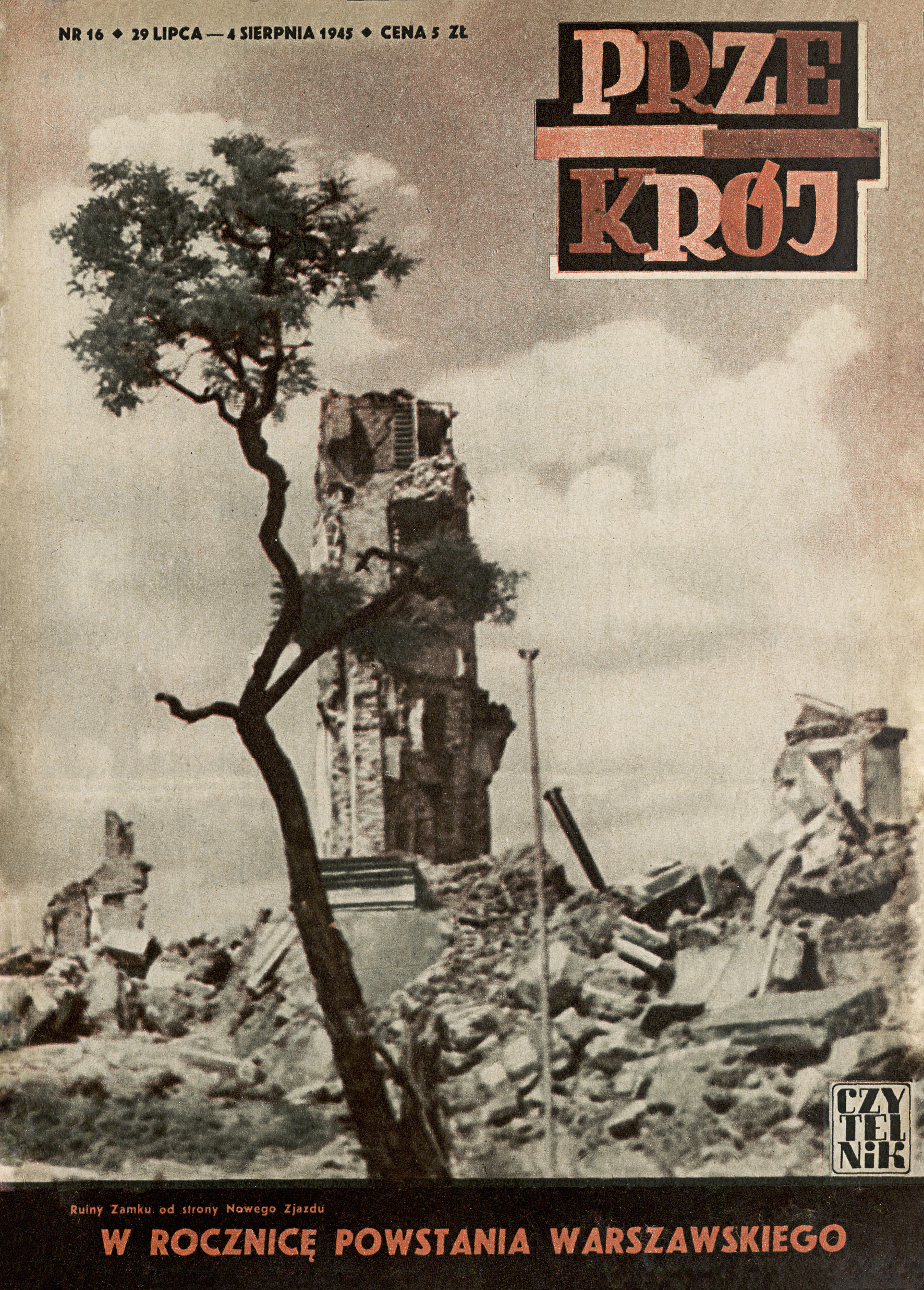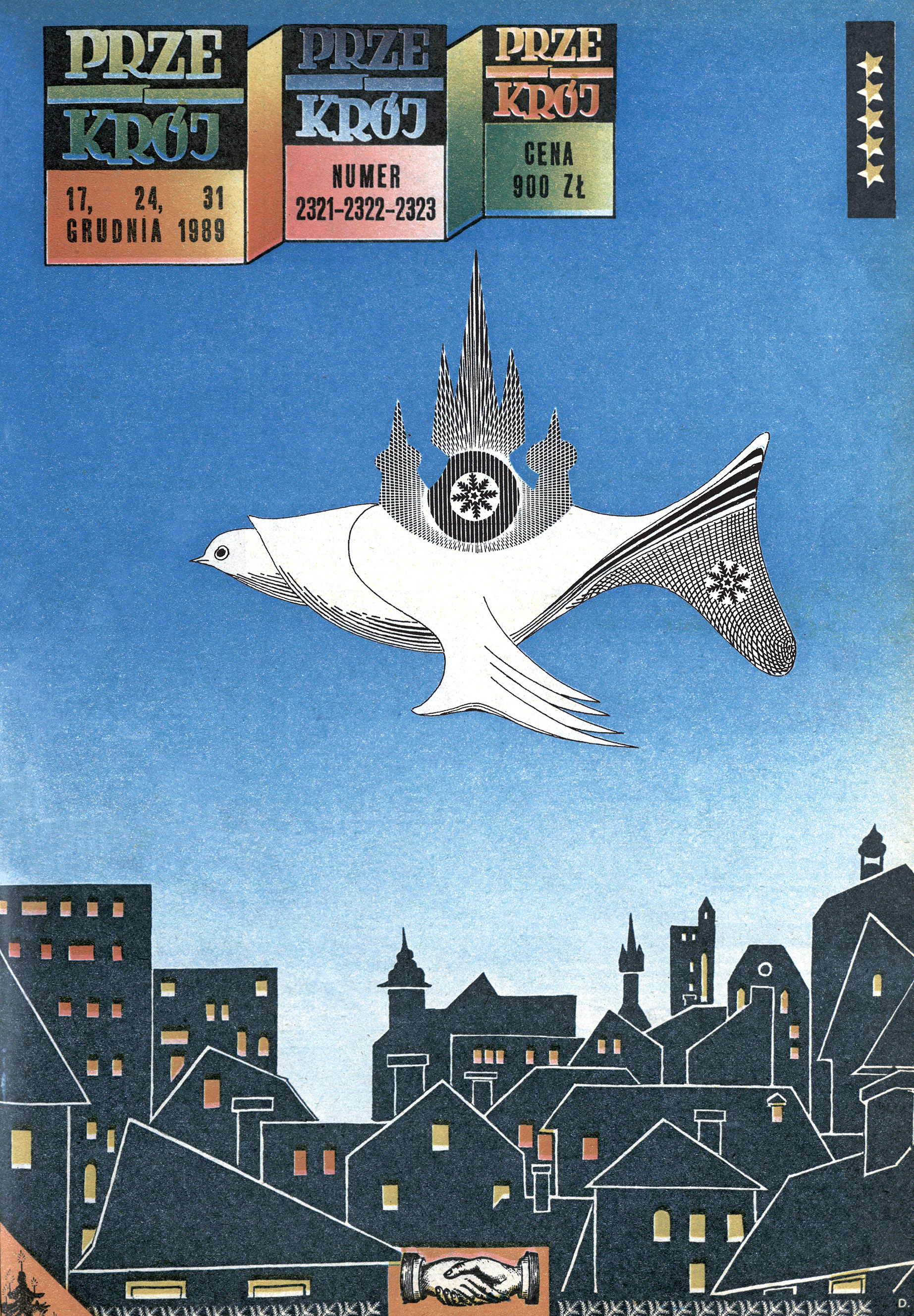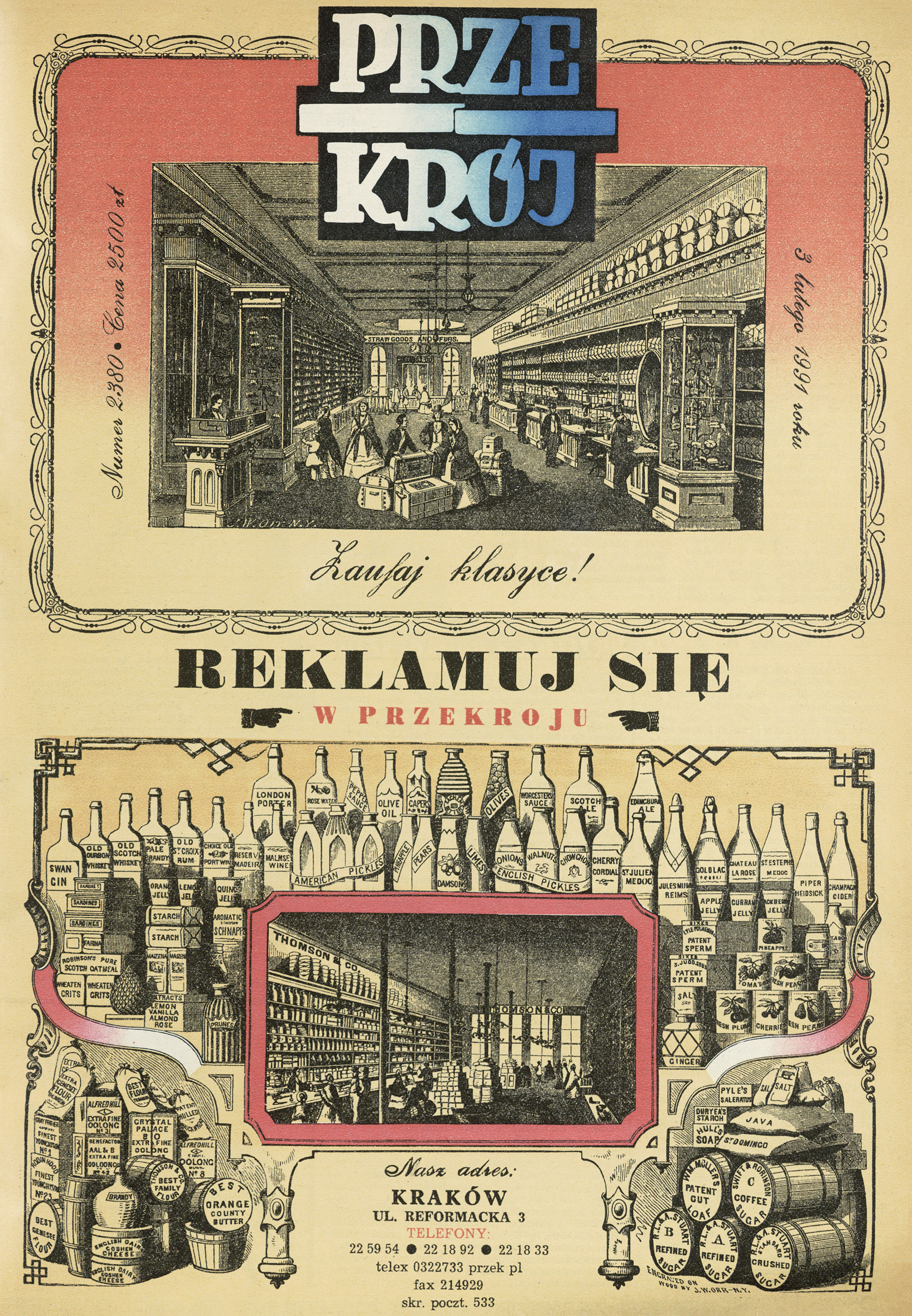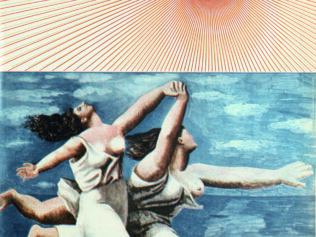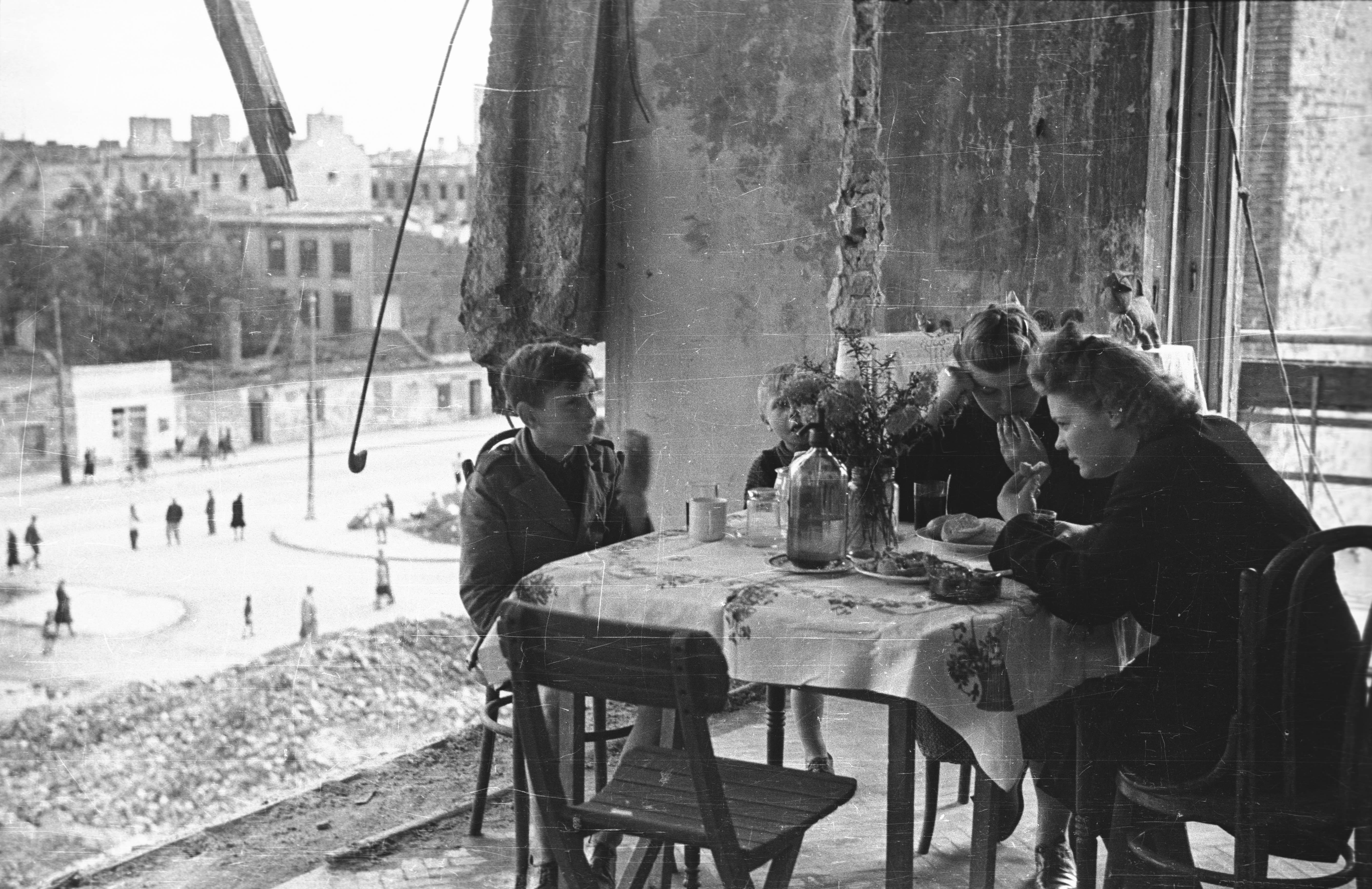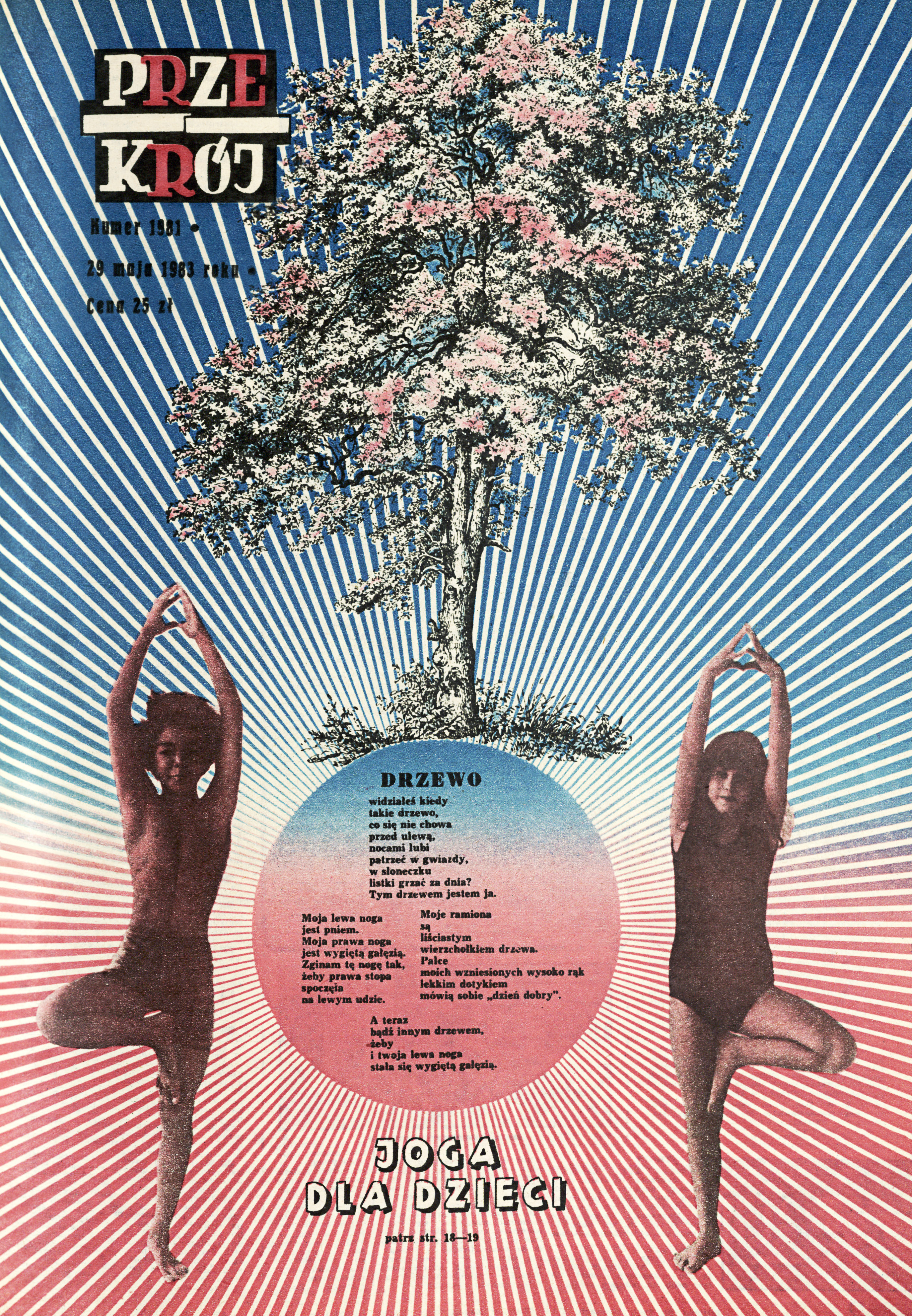
Some difficulties arise when we discuss the aesthetic values of the cover of the 16th issue of “Przekrój”. It went on sale at the end of July 1945 and focused mainly on the Warsaw Uprising.
As the caption informs us, the photograph depicts the ruins of the Royal Castle seen from Nowy Zjazd. I’m glad that the caption is there – otherwise, it’d be impossible to identify this pile of rubble. There are similar photos inside, and they all depict total and utter destruction. There is also a spread with Ludwik Cieślik’s drawings from a series entitled Warszawa cierpiąca [Warsaw Suffering] with meaningful titles: Powstańcy w okopach [Insurgents in the Trenches], Atak czołgów odparty [Enemy Tanks Fought Off], Po wygnaniu z domów [Banished from Their Homes], Obóz w Pruszkowie [Camp in Pruszków]. Today, the extreme images may surprise readers who only know the later issues of “Przekrój”. In the first two or three years after the war, the weekly published a number of shocking photographs documenting the aftermath of the Uprising. It is unthinkable that any magazine would print such shots today. We now have a different pain threshold. Thankfully.
At the time, the editorial team consisted of people who would be associated with the title for many years to come. The covers were designed by Jan Maria Brzeski, one of the pioneers of avant-garde film and collage art in the 1930s. Marian Eile had been the editor-in-chief of “Przekrój” from the start. He succeeded in securing Czesław Miłosz, Jerzy Putrament and Jerzy Andrzejewski’s collaboration; the trio had already managed to reach Kraków and resided at Dom Literatów at 22 Krupnicza Street, the foothold for homeless authors following the war. They wrote the three most substantial texts featured in this issue – and all three focused on the Uprising.
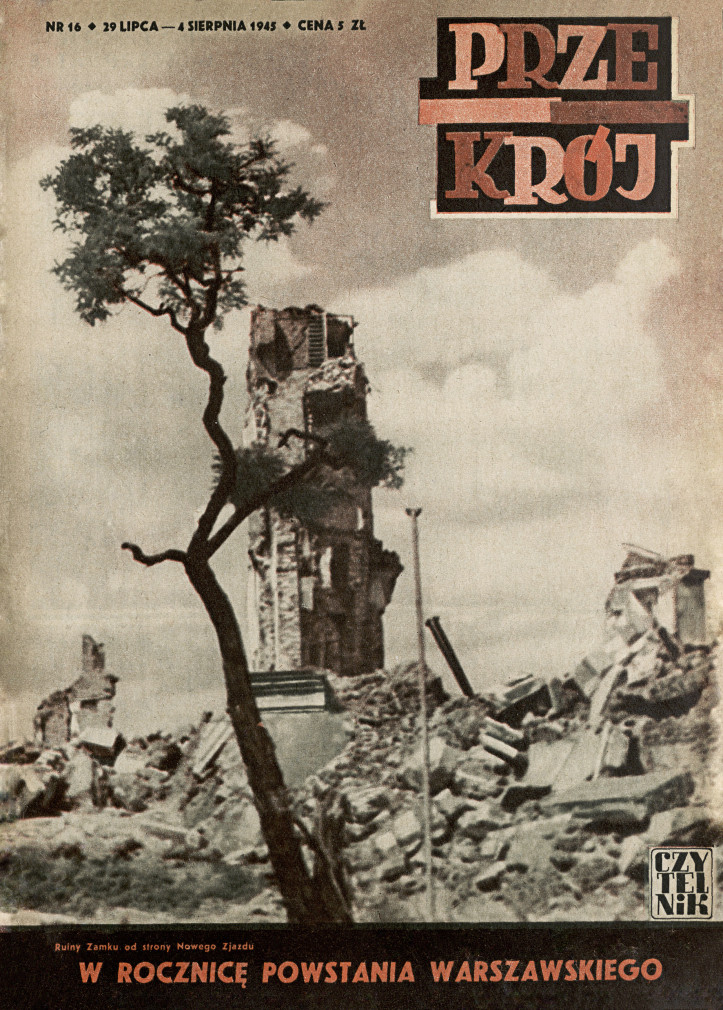
“I spent the war where the proletarian Madalińskiego, reminiscent of the streets of Łódź, crosses the sparsely developed Niepodległości Avenue – this pocket of Mokotów, where solitary high-rise residential buildings, factories and wooden sheds border the fields,” begins Miłosz. And he continues: “The landscape has changed over the years. More and more vegetables have been planted, between metal railings riddled with bullets and in the neglected squares flattened in 1939 – until the entire district resembled Warsaw as it was during the war: potatoes, broad beans and tomatoes growing abundantly along the streets. This rural Warsaw entered the Uprising and this is how I’ll remember it. […] Then the Uprising came and it played out on the stage of potato and oat fields, bordered by large buildings. Boys in long boots and breeches, armed just with revolvers, guns so small that they could fit in the palm of a hand, shouted ‘onward’ and ran towards the Mokotów forts, followed by Warsaw girls, dressed up, their hair permed – girls that were great in love and wonderful in heroism. It was humid; mosquitoes devoured the men skulking between the potato plants. German light flares enclosed them with a glistening cover. The rain fell and soaked the living to the bone, rinsed the dead.”
On the next page, Andrzejewski writes: “A year ago, the first barricades were erected on the streets of Warsaw, and the first shots were fired in Śródmieście, Wola, in the Old Town and Żoliborz. Although separated by a year of great changes, this memorable day, 1st August, is too vivid, to dear for us to entrust it to the misery of legend. The righteousness of future generations is not the same as the righteousness of the witnesses. Time can heal and simplify many matters. The wrath of the fathers does not pass on unscathed to their sons and grandsons, and the memory of the suffering of others leaves us free of their anguish. […] Our history is full of many, increasingly mythologized, tragedies and graves dug up by turmoil and violence. For over two hundred years, each generation sacrificed their blood to defend their honour and left behind their own own graves. Apart from Poland, there is probably no other nation in the world where people would willingly die for the sake of such great and lasting values, while simultaneously being tied up with such a bad and wrong politics.”
This year, we celebrated the 76th anniversary of the Warsaw Uprising. As is now customary, the celebrations were marred by an atmosphere of disagreement. Ironically, the self-appointed heirs of the insurgents are more and more often groups that are, in fact, fascist. Andrzejewski notes: “Some of us lost the capital and others their hometown, but we should not be tempted to pass judgment on that day. It was barely a year ago and everything that we experienced while Warsaw was on fire and our relatives and friends perished among its ruins is still raw, painful, and restless within us. We remember each of those days; their hope, their disdain, rebellion and resentment, and despair, and also their heroism. […] If we were to allow the criteria of political righteousness to govern our attitude towards the past, we would have to abolish numerous legends and remove the symbols of heroism and sacrifice from many, many graves. We would have to repeat often: here lie the people who have pointlessly given their lives. Still a deep, strong instinct prevails and prevents us from passing such judgment.”
Putrament, writing under the name Wincenty Bednarczuk, notes: “The Warsaw Uprising is a complex event, difficult to discuss and to evaluate, and will surely be examined by historians in the years to come. As in a lens, it focused on our national merits and flaws. Various, often opposing forces were at play and when thinking about the Uprising, we must remember the internal contradictions that tore it asunder. Let us imagine a large water reservoir, for example, the Rożnów dam and power plant. This water bears an immense power. What can this power do? It depends. It can help the entire country, replacing millions of workers, heating and illuminating hundreds of cities and villages. It can also destroy this country in one violent, unstoppable flood. It may also sink into the ground, unproductively. It all depends on who will direct this energy, how it will be used and for what purpose.”
These words were written in 1945, one year after the Warsaw Uprising, when its memory was still raw. The sight of Warsaw, razed to the ground, was an everyday sight, not just the cover of an old magazine. People still remembered the faces of the fallen and the slain, the smell of dead bodies, and the mistakes of the command. “What was it for?” people wondered. Was it worth it? Did they sacrifice their lives for nothing?
In 1945, the writers still enjoyed a certain freedom of expression that would soon disappear, only to be replaced by socialist realist unanimity. The rigid Stalinist doctrine damned the Uprising as a reactionary hoax. After all, it was politically aimed at the Soviet Union, the greatest friend of the Polish people. Of course, it quickly turned out what kind of friend it really was. And this is probably why decade after decade, outside of the official circulation, the myth of the Uprising as an unsullied, faultless act, necessary for the survival of the Polish spirit, was perpetuated. Today’s Third Polish Republic has inherited this myth.
“Time can heal and simplify a lot,” predicted Andrzejewski.
Translated from the Polish by Joanna Figiel


